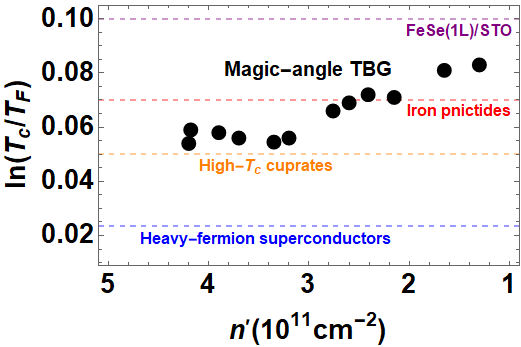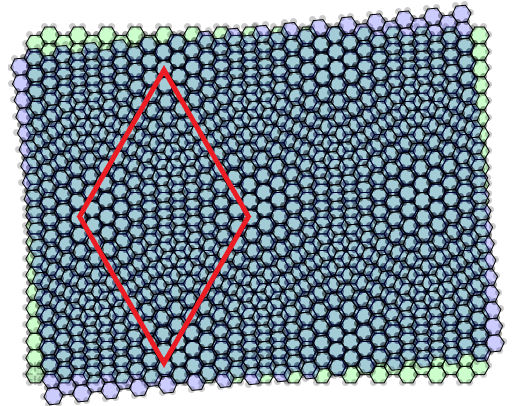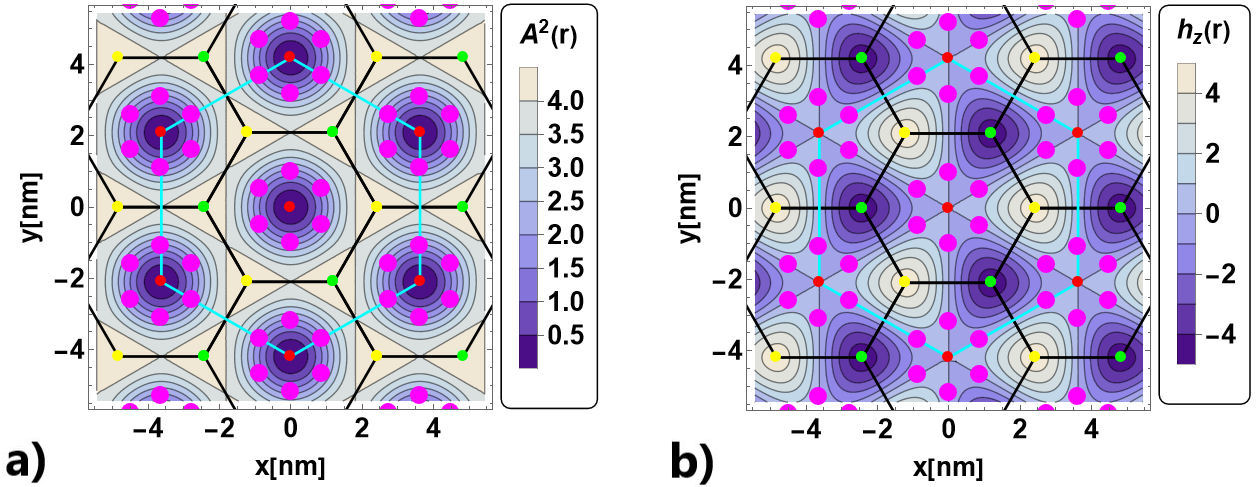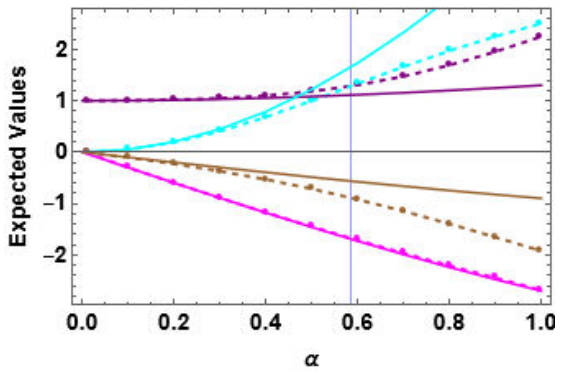1 Introduction
Recently it has been showed that twisted bilayer graphene systems support superconducting phases at certain special twist angles [1, 2], where electronic correlations are maximized due to the existence of flat-bands [3]. Moreover, Cao et al. [1] found that such TBG systems have a Mott insulating phase that appears in the middle of unconventional superconducting phases, similar to the phase diagram found in cuprates and other high temperature superconductors [4]. The appearance of a Mott correlated insulator and unconventional superconducting phases in the flat band of magic-angle TBG at a small carrier density cannot be explained by weak-coupling BCS theory [5- 14]. In fact, although T c is very small, of the order of 1.7K, the electron-electron coupling turns out to be very high. In Fig. 1 we show the variation of In(T c / T F ), where T F is the Fermi temperature and T c is the critical temperature of the superconducting phase as a function of the charge doping n’. This plot intends to compare the electron-electron coupling once the density of carriers and T F are taken into account. The magic-angle TBG T c / T F ratio is above the trend lines on which most heavy fermions, cuprates and organic superconductors lie [1]. Thereafter, it has been experimentally found that trilayer graphene rotated by magic angles turns out to be the highest ever found electron-electron correlated material [15]. Up to now, the origin of superconductivity in TBG remains under debate.

Figure 1 Variation of In(T c / T F ) (logarithmic scale) as function of n’ (charge doping) in scaled units of 1011 cm-2 for magic-angle TBG (blue points). Here T c is the critical temperature for a superconductor state and T F is the Fermi temperature. The horizontal lines indicate the approximate T c / T F values of the corresponding family of materials. Adapted from Ref. [1].
An interesting strong coupling theory of superconductivity based on skyrmions could explain the mechanism of superconductivity in TBG [11]. For this purpose is important to understand the quantum geometry of flat bands in magic-angle TBG which is purely the mathematical structure necessary to measure distances at the quantum regime. Also is important to analyze the interplay between interaction range and Berry curvature inhomogeneity. A deeper theoretical study by Ledwith et al. [16] based in vortexability and the importance of chiral symmetry to induce vortexable bands as a generalization of the LLL (Lowest Landau Level) for hosting a short-range interacting ground state (SRI-GS) is of great relevance. Vortexable bands are a class of bands to which one can attach vortices while remaining within the subspace defined by the bands. This treatment of vortexable bands allows the construction of exact many-body FQHE (Fractional Quantum Hall Effect) ground states in the limit of short-range interactions, and possibly vortexable bands of equal and opposite Chern numbers related to superconductors based on skyrmions. On the other hand, magic-angle TBG has flat Chern bands at zero magnetic field. Therefore, TBG promises a route towards stabilizing zero-fields Fractional Chern Insulators (FCIs) [17].
In fact, the study of the electronic properties of twisted bilayer graphene started before the discovery of superconductivity at magic angles. In works of 2007 by J. Santos [18] and 2011 by A. Macdonald [19], an effective low energy continuous Hamiltonian model was derived.
In such studies the idea was to generate moiré patterns as a function of the twist angle between graphene layers. In Fig. 2 we show the unit cell for the moiré pattern of TBG. The new unit cell vectors in the moiré lattice are scaled as the inverse of the twist angle between layers, therefore, for small twist angles, it is expected to have a bigger moiré unit cell. Form there is possible to define a moiré Brillouin zone (mBZ). For small twist angles, the mBZ is also small due to the moiré modulation vector. Flat-band were found at certain angles and from there superconductivity was predicted [19].

Figure 2 Picture of twisted bilayer graphene (TBG) system. The graphene monolayer 1 (green) and monolayer 2 (purple) have a relative twist angle that produce a moiré pattern (cyan) with a unit cell much bigger than the original unit cell of each monolayer graphene. The unit cell of the moiré pattern is indicated (red).
The reason for the appearance of flat bands and its quantized nature is not understood. Therefore, lots of research have been conducted in this direction. Notice that flat bands can also occur in graphene over substrates even without twists yet TBG systems are paradigmatic. To make the TBG model more realistic, G. Tarnopolsky et al. [20] took into account the structural relaxation due to carbon-carbon repulsion between layers and a chiral continuum model was produced. Perhaps, so far, it is the simplest and more realistic model that best captures the nature of magic angles; at these special angles the dispersion energy at the lowest bands becomes flat and has a recurrence behavior. Also at these magic angles the Fermi velocity goes to zero. Due to its chiral symmetry, the Hamiltonian of this model produces an intra-valley inversion symmetry [21] so the energy dispersion is inversion symmetric at all twist angles and thus symmetry protected at any twist angle. The zero-mode have some resemblance to the ground state of a quantum Hall effect wave function on a torus [20, 22], and, therefore, the solution is of the quantum harmonic oscillator type, where Landau levels arise [23, 24, 25]. Another interesting mathematical characteristic is that flat-band modes are constructed from a complex analytic functions that are ratios of the theta Jacobi functions [20, 22].
Furthermore, due to the quantized nature of the magic angles it appears that there is an adiabatic change in integers of this topological invariant. However, there are many open question concerning the possible relationship between the quantum hall effect (QHE) and the TBG, the quantized nature of flat-bands and the nature of wave functions.
In a series of previous papers, the authors showed that by making a supersymmetric transformation akin to take the square of the original chiral TBG hamiltonian, the physics behind the magic angles becomes clear [26, 27, 28]. The aim of this work is to review the topic and clarify the physical behavior of this model as well as to develop an effective equation for such squared Hamiltonian in order to study all other non flat band states. Although one of the authors presented before in this journal some details of the squared Hamiltonian model [29], here we go further by showing that the effective system is related to pseudo-magnetic fields, bringing the possibility of writing the squared chiral TBG Hamiltonian in a non-Abelian fashion where effective magnetic fields appear, making the connection with the QHE transparent. Then we discuss the physical picture that arises from this minimal model including an analytical calculation of the first magic angle to show how this arises as a balance between kinetic, confinement energies and interlayer currents.
Let us finally add that the original 4 × 4 Hamiltonian is an effective model that contains hundreds of atoms in its unitary cell which is of the size of nanometers (see Fig. 2). However, it is made from a basis with bi-spinors and thus can be thought as representing the dynamics of two coupled quasiparticles. Therefore, one can still interpret the original 4 × 4 as two quasiparticles in a non Abelian field. However, this is much more difficult to visualize than in the approach presented here, where one of the quasiparticles is renormalized by squaring the Hamiltonian.
2 Chiral TBG system
The Bistritzer-MacDonald Hamiltonian (BMH) model arises by a simple stacking of two rotated graphene layers with an interaction between them [19]. One of the authors gave a simple derivation of this model in this journal before and thus we refer the reader to it [29]. Although the BMH contains the magic angle physics, in real TBG stacking points where carbon atoms are on top of another carbon (known as AA stacking) are pulled apart out of the intralayer plane due to Coulomb repulsion. As a consequence, interlayer electron tunnelling in AA sectors is greatly reduced and can be safely neglected. This result in a chiral Hamiltonian (CH) [13,
20]. Let us write this model. Consider as basis the wave vectors
where we defined the zero mode operator as,
and its rotated and conjugated version,
We also defined the antiholonomic operator,
and the holonomic operator,
Both operators eventually play an important role in the theory, as the flat-band wavefunctions are in part determined by the fact that the antiholonomic derivative of any analytic function is zero [28]. Although these operators appear in graphene, the lack of a position dependent potential in graphene allows to solve the problem in a very simple way without the need to look for the analytical properties of solutions. The interlayer potential is [20],
Here
The distance between each layer graphene Dirac cone is
where
Here we will use units where
To finish the model, we found useful to define a set of unitary vectors
3 Squared TBG Hamiltonian and Pseudo-magnetic fields
In a previous work [26] we showed how, by taking the square of H, which is akin to consider a supersymmetric model, it is possible to write the Hamiltonian as a 2 × 2 matrix. This transformation takes into account the particle-hole symmetry and folds the band around E = 0. Physically, it removes one of the bipartite lattices on each layer, leaving two triangular lattices on each layer. In a series of previous works we investigated several properties of this Hamiltonian, among the most important is the mapping of the flat-band into a ground state separated by a gap form the rest of the states. This state has an antibonding nature in a triangular lattice and then has frustration, associated with a massive degeneration [32]. The connection with supersymmetry is important as there are many recent articles exploring several properties such as topology and supersymmetry on lattice systems and which are of great relevance, thus we refer the reader to them [33, 34, 35, 36]. In this context is specially intriguing the relationship found before between the squared TBG Hamiltonian and a boson Hamiltonian describing phonons in a flexible system[26].
For the present work we decided to change the notation used in such works and write H 2 in terms of a more physically suggestive picture by using pseudo-magnetic fields,
where
and,
which turns out to be a two-dimensional pseudo-magnetic vector potential in the Coulomb gauge as is easy to prove that
which has the property,
where the cross product between two-dimensional vectors given by
Such cancelling can be graphically understood in Figs. 3a)-b) where we plot the pseudo-magnetic vector potential in real space. Notice that B has an imaginary part which at first sight seems to be an odd fact. However, after the first experimental observation for such effective fields in the evolution of quantum coherence of a spin coupled to an Ising-type spin bath [37], there are lots of works dealing with the subject [38, 39]. Here it can be interpreted as in Ref. [37], i.e., the quantum space evolution introduces a complex phase factor inside the field. On the other hand, in Figs. 3c)-d) is shown the pseudo-magnetic scalar field. In both cases, we have a Kagome geometry for the pseudo-magnetic fields of the squared hamiltonian.

Figure 3 In panels a) and b), we show the real and imaginary parts of the pseudo-magnetic vector potential
4 Non-Abelian model for TBG
Let us now explore the nature of Eq. (8). In analogy to an electron in a pseudo-magnetic vector potential, we define the canonical momentum,
where
with
Note that
Using the canonical momentum with natural units
Eq. (17) can be further simplified to,
where
Now we investigate the Zeeman term. We start by observing that,
from where,
Substituting Eq. (20) in the commutator Eq. (19), it follows that for
where we specified that the commutator must be taken at the same point. We also used that
multiplying by
where we defined the potential of the non-Abelian term
In Fig. 4 we show the contour plot in real space for the potential

Figure 4 Representation in real space of a)
The other term of the Zeeman coupling is related to the pseudo-magnetic scalar potentials as follows,
but
where
In the same way, the square of the non-Abelian pseudo-magnetic vector potential
It follows that,
and therefore
Using all these results, it is possible to write the square Hamiltonian Eq. (8) in a way that manifest more clearly its non-Abelian nature. We start by writing H 2 purely in terms of A,
where
where we defined
As proved in Ref. [29], in the limit
5 Strong non-Abelian limit: first magic angle perturbative solution at
In this section we will explore the strong non-Abelian limit of the hamiltonian and its relationship with the first magic angle. Before doing so, and as explained elsewhere [29], the
The expected values for a given layer j = 1,2 are, the kinetic energy,
the confinement energy,
and the energy contribution from the off-diagonal operators,
here
where the index j = 1,2 for take into account the two layers.
For the
and
It follows that,
In Fig. 6 we compare these perturbative expected values with those obtained from the numerical results (see the appendix) showing a very good agreement for

Figure 6 Expected values in the
Therefore,
Then we conclude that in going from
6 Weak Non-Abelian limit and higher order magic angles: equivalence with the Quantum Hall effect
As we discuss below, for higher-order magic angles the non-Abelian effects are weak since the system can be treated as if the magnetic field is constant due to a strong confinement. In fact, we recently proved that the H
2 hamiltonian converges into the Quantum Hall effect hamiltonian, i.e., it is equivalent to a two dimensional quantum oscillator [28]. We refer the reader to this reference for more details. Here we only make some remarks concerning the strong confinement. To show how it arises, consider the zero-mode equation
In the limit
From there it is possible to prove that flat-band states converge into coherent Landau levels [28]. These are the smallest wave-packets that can be constructed from states within the lowest Landau level [28]. The resultant electron density is made from a linear combination of Gaussians [43] with mean deviation given by
7 Conclusion
The chiral TBG Hamiltonian is equivalent to an electron inside of a non-Abelian pseudo-magnetic field. Here we gave its corresponding general expression. Then we explored the first magic angle using perturbation theory to show how the kinetic, confinement energy and interlayer currents produce a magic angle. For the first magic angle results that the non-Abelian properties are more important than other higher magic angles because the commutator becomes less important. Therefore, in the limit











 nueva página del texto (beta)
nueva página del texto (beta)



